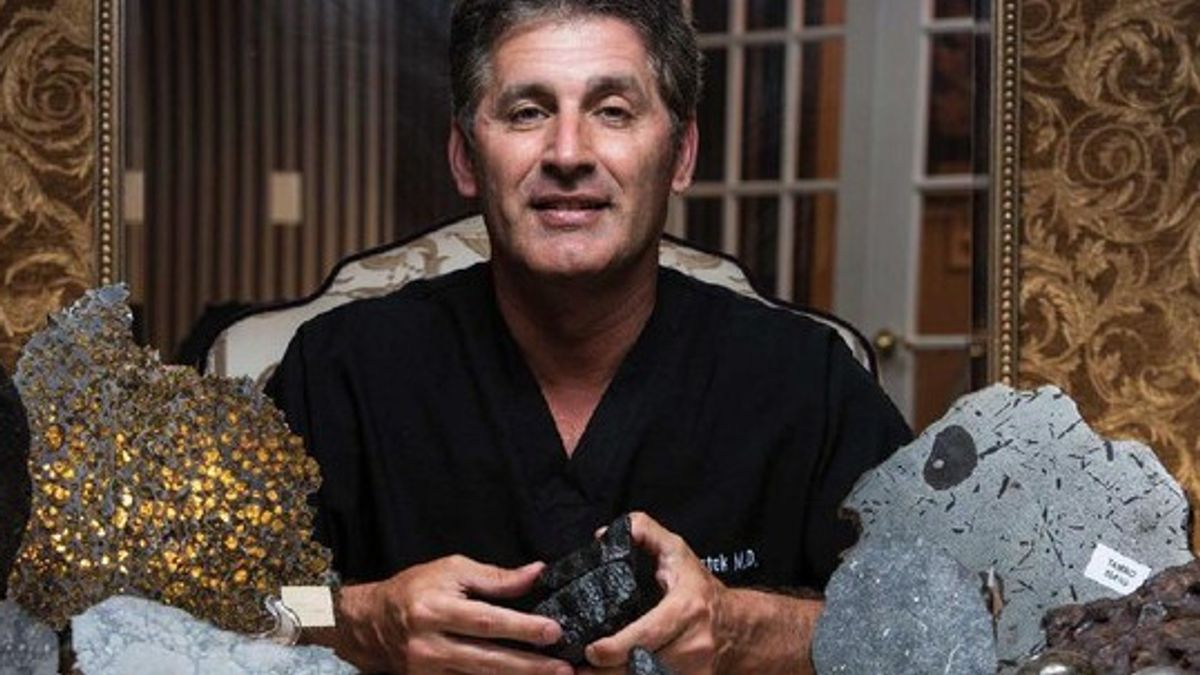JAKARTA - News regarding the fall of a meteor that hit Josua Hutagalung's house in Kolang, Central Tapanuli, North Sumatra is still hotly discussed today. There are many puzzles as to who the collector behind the buyer of Josua's space rock is.
According to the Lunar and Planetary Institute in Texas, United States (US), the meteorite is classified as CM1 / 2 Carbonaceous Chondrite. This extremely rare celestial body is officially nicknamed Kolang.
Initially, the meteor was reported to have fallen into the hands of US citizen Jared Collins, who offered a pretty fantastic price to Josua.
Quoting the Daily Mail, Sunday, November 22, Collins is a meteor expert in his country. He was then asked by a collector named Jay Piatek to secure the meteorite and negotiate a price with Josua.
"My cell phone lit up with a crazy offer for me, I then ordered a plane ticket. I took as much money as I could collect and went looking for Josua, who turned out to be a shrewd negotiator," said Collins.
Collins gave Josua Rp. 200 million for the chunk of the meteorite. After the transaction, he immediately sent it to the US, and officially became Roger Jay Piatek's private collection.
Who is Roger Jay Piatek?Science Mag proclaimed, Piatek is someone who has been passionate about meteors since 2003, his hobby has also been known in the US astronomy community. Before becoming a meteor rock collector, Piatek graduated from Indiana University medicine and became a doctor until he opened the Piatek Institute nutrition clinic, in the city of Indianapolis in 1995.
Piatek admitted that he became interested in meteors when his son was in grade 4 Elementary School (SD) who was learning about meteorites at school. Even so, Piatek is well aware that getting this sky stone is not as easy as imagined, because at that time the meteor was only owned by a space research institute or a museum.
Not losing his mind, Piatek then searched the eBay trading site, where he visited various rock and mineral exhibitions. After getting a gap, he then opened a network with a community of scientists and space research institutes around the world, in order to satisfy this unique hobby.
From this hunting intention, Piatek managed to collect as many as 1,300 meteor stones. Ranging from rare or not. Unfortunately, then he fell ill and made him decide to sell the 400 meteors he owned.

The 53-year-old man revealed that of the 1,300 meteor stones in his collection, he has one of the most valuable meteors, namely Black Beauty. Every pebble embedded in the meteorite has a history that must be unraveled. Black Beauty does not only hold geological stories but also huge anthologies.
However, Piatek admitted that he had sold it to a technology company boss, Naveen Jain. Piatek said the rock fell in Morocco millions of years ago, and was discovered by Moroccan nomadic tribes in 2011.
Piatek claims, the rock comes from the Red Planet or Mars. Without thinking, he immediately bought Black Beauty through an intermediary seller of precious stones and meteors named Aziz Habibi for Rp.85.2 million.
The discovery and sale and purchase of the Black Beauty meteor shocked the world, because the stone actually has a price of up to US $ 10,000 per gram, and there are only 2kg in the world. Meanwhile, Piatek received approximately 1.4 kg or the equivalent of 14 million US dollars (Rp199 billion).
The other side of Roger Jay PiatekAlthough the transaction was fun for him, Piatek said he never really understood the value of collecting these space stones. "I (only) have things that no one has," said Piatek.
However, when he has the most important goal of completing his collection of meteor pallasites, which are beautiful meteorites containing green olivine crystals suspended in a gray matrix like luminous spots, Piatek can't help but jump in to unravel the mystery of the meteor. It is known, of the 59 pallasites that may be obtained (several others are in the untouched collection), Piatek has 57.
One of them, the pallasite El Rancho Grande, comes from Agee, a former chief scientist for NASA's Johnson Space Center in Houston, Texas, and is now the curator of the University of New Mexico meteorite collection. Their relationship is getting very close when it comes to finding out the origin of Black Beauty. Piatek sent the rock to Agee, who was not at all sure it was a meteorite. Because it is claimed to have no chondrite weight, which is usually rich in solid metals.
Not surprisingly, Agee and Piatek abandoned the stone for several months. Finally, in the fall of 2011, they researched it by taking a diamond-tipped rock saw, cutting off one end of the rock. Then, they were suddenly amazed at what he saw in it, like the history that existed during the time of Apollo.
Where can I find rare meteors?If you are interested in a meteor it means that you will both hunt and study the celestial body. In order not to be misinformed, you should visit a place that is sure to provide proper knowledge, right? One of them is the museum, curious about where the meteor museum is located? Check out the following list.
1. UCLA Museum
This museum is located in New York, USA. It has the Clark Iron meteor, a 357 pound (162 kg) Canyon Diablo meteorite. This meteor is a striking shape produced by a combination of erosion during atmospheric travel.
The museum also has Chondrite meteors, which are the oldest extraterrestrial rocks in the Solar System, they are older than planet Earth. There are 2 species of UCLA.
2. American Museum of Natural History
When you visit this museum, you will find a number of answers to important questions about the origin of our Solar System some 4.6 billion years ago by examining meteorites.
Sometimes, these rock fragments from outer space reveal clues about the formation and evolution of the Sun and planets.
More than 130 scientifically significant meteorites are featured here, including the 34-tonne Cape York Meteorite, also known as Ahnighito. In addition, they also displayed rare specimens of Mars and lunar rock collected during the Apollo missions in the 1970s.
3. Institute of Meteoritics Meteorite Museum
The Meteorite Museum is part of the Meteoritics Institute, opened in 1974 and is a major educational resource for universities and schools in New Mexico.
The museum exhibits many samples of rock and iron meteorites from the institute's collections. The meteorites on display at the museum are only a small part of the research and teaching collection, which includes more than five thousand specimens from 650 samples. All meteorites in the collection are available for study by researchers within the institute and around the world.
4. Smithsonian National Museum of Natural History
It is known, this museum is also in collaboration with NASA, where they house a national meteorite collection, which includes more than 55,000 specimens of more than 20,000 different meteorites.
The Smithsonian provided an early characterization of the newly collected Antarctic specimens and, ultimately, their distribution permanently to the scientific community. This meteorite is stored at the Museum Support Center facility in Suitland, Md. Nearly 16,000 Antarctic meteorites have been collected since 1976, and more than 14,000 of them have been permanently moved to the Smithsonian.
The English, Chinese, Japanese, Arabic, and French versions are automatically generated by the AI. So there may still be inaccuracies in translating, please always see Indonesian as our main language. (system supported by DigitalSiber.id)










